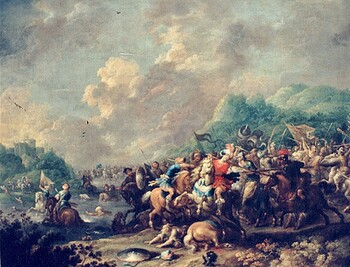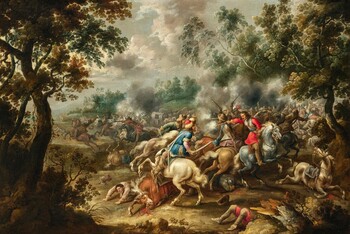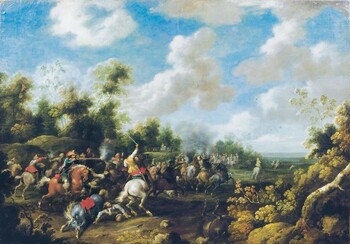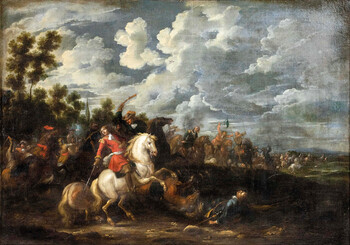8.300 €
Battle scene between Turkish and European troops
Oil on copper : 52,0 X 77,0 cm
(at the backside it is protected by a modern wooden panel)
Monogrammed lower right “AL.C.”
Frame : 68,6 X 93,7 cm
In short
Alexander Casteels the Elder specialised in large battle scenes, painted on canvas, which were often exported to Vienna.
During the second quarter of the 17th century Ottoman armies engaged more and more in campaigns along the Habsburg frontiers in Eastern Europe.
Our battle scene is typical of Casteels, but he painted it in a much more detailed way on the smaller surface of a copper plate.
About Alexander Casteels I
Flemish painter
Antwerp circa 1635 – 1681/1682 Antwerp
In the past it was erroneously said that our painter passed away in Berlin in 1694, but that was his son, Josephus Franciscus Casteels.
Painter of battle scenes and of hunters in landscapes.
Member of a large dynasty of painters in Antwerp, whose family ties have not been exactly unravelled.
Our Alexander I was very probably the son of a further unknown painter called Pieter Casteels I and a brother of Pauwels Casteels (circa 1625 – in or before 1697), also a battle scene painter. There are obvious stylistic similarities between both painters. Both loved painting large heroic battle scenes: either biblical, Greek or Roman subjects or contemporary clashes between Christians and Turks. Their battle scenes seem to have been popular in Central and Eastern Europe, especially in Vienna. Pauwels and our Alexander the Elder were clearly influenced by two earlier Flemish specialists of battle scene paintings: Pieter Snayers (1592 – after 1666) and above all Pieter Meulener (1602 – 1654).
Alexander joined the Painter’s Guild of Antwerp in the year 1658/59.
He got married in his hometown in 1659, the couple had three children, all sons.
Alexander Casteels II (circa 1665 – after 1716) was an Antwerp draughtsman of architectural themes. As he is very little-known many authors have called our painter “Alexander Casteels”, as they did not feel the need to differentiate him from this younger artist.
About our painting
Alexander Casteels specialised in (very) large battle scene compositions painted on canvas. Our monogrammed painting is painted on a copper plate. It was therefore much finer and much more meticulously painted and thus more sought-after. The Musée des Beaux-Arts of Orléans also holds a battle scene on copper by our artist.
The representation of military clashes between European and Turkish armies were particularly popular during the second half of the 17th century, because of the growing threat of Turkish invasions in Europe.
The appearance over Europe of comet Halley in 1682 was a bad omen.
One year later, a huge Ottoman army pushed without any resistance forward thru Eastern Europe all the way to Vienna, capital of the Holy Roman Empire. September 12th those troops were beaten in the Battle of the Kahlenberg. Never again would an Islamic army push forward this deep into Christian Europe.
About paintings on copper
Seventeenth and eighteenth century Flemish (and Dutch) artists painted on oak panels, on canvas and on copper. Copper was the most expensive, but also the best support. Wooden panels can suffer from sudden changes in the degree of humidity, canvasses can be torn, while copper plates are less vulnerable.
Because of their even, highly rigid and non-absorbent surface, coppers did not need a preparatory layer (sometimes only a very thin ground) and one can paint extremely precisely, the paint could be applied almost without any visible brushstrokes. In old recipes it was advised to rub the copper plate with garlic, so that the oil paint would adhere better.
As copper was more expensive and as one could paint in a very detailed way on them, most copper plates are therefore of rather small dimensions. Artists painted on copper delicate, elaborate and highly finished paintings with brilliant pictorial effects, carefully rendering the details of physiognomy and of dress. Another advantage of these copper plates today is the fact that they have very little craquelure.
Why should you buy this painting?
Because the brilliant depiction of an exotic battle scene and of Ottoman military leaders testifies to the fear of the Islamic, Turkish threat at that time.
Comparative paintings
Click photos for more details








